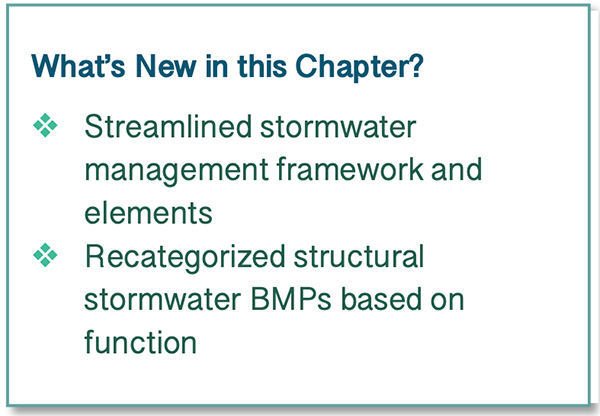Click on the headers for PDF access of these sections of the Manual
Introduction
Managing the stormwater impacts of land development requires the selective use of non- structural and structural stormwater control measures. Low Impact Development (LID) site planning and design is a critical and effective element of a successful stormwater management approach because it addresses the root causes of both stormwater quality and quantity problems by helping to preserve pre-development site hydrology and pollutant loads. Source controls and pollution prevention, as well as construction erosion and sedimentation controls, are also key elements for preventing or mitigating stormwater quality problems. These preventive measures can reduce the size and scope of structural stormwater Best Management Practices (BMPs). However, it is also recognized that structural stormwater BMPs, in combination with LID and other non-structural measures, are often necessary to fully meet stormwater quality and quantity control objectives.
This Manual addresses stormwater quality and quantity using LID site planning and design strategies, source controls, and structural stormwater BMPs. Construction-phase soil erosion and sedimentation controls, storm drainage facilities (catch basins, manholes, storm sewers, etc.), and flood mitigation/control are addressed as secondary topics as they relate to stormwater quality for more detailed guidance refer to the Soil Erosion and Sediment Control Guidelines. Other statewide design guidance documents, as well as local ordinances and requirements, should be consulted for more information on these topics.
Guiding Stormwater Management Principles
This Manual aims to adhere to the following principles:
- Preserve pre-development site hydrology
- Provide minimum average annual reductions in post-development pollutant loads
- Preserve and protect the natural features which protect water quality
- Manage runoff and prevent increases in downstream flooding / erosion
- Prevent pollutants from entering local waterbodies and wetlands
- Seek multi-objective benefits from stormwater control measures
LID Site Planning and Design
LID refers to the use of non-structural and structural measures to counteract the impacts of development. Three main approaches to LID site planning: avoid, reduce, and manage the impacts of development. More information about LID planning can be found in Chapter 5.
Source Control Practices and Pollution Prevention
Focus on the use of source control practices and pollution prevention, in conjunction with LID site planning and design, to minimize contact of potential pollutants with stormwater. More information on these practices can be found in Chapter 6.
Construction of Soil Erosion and Sedimentation Controls
Measures for controlling soil erosion and sedimentation during construction must be described in site-specific Soil Erosion and Sediment Control Plan in accordance with the CT Guidelines for Soil Erosion and Sediment Control.
Structural Stormwater BMPs
General overview of structural stormwater BMPs as stormwater management systems to reduce the discharge of pollutants and volume of runoff from development sites. More information is presented in Chapters 7 - 13 of the Manual, addressing selection, design, construction, and maintenance of structural stormwater BMPs.
